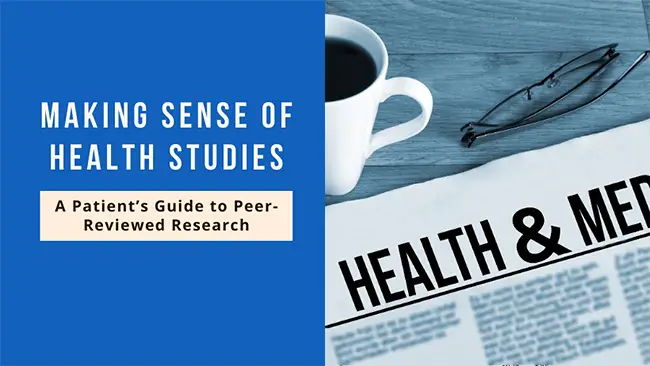
Health is a topic that affects us all, yet remains one of the most confusing areas of our lives. We are bombarded with health information daily, often contradictory, and many of us are left feeling more uncertain than before.
So how do we sort the fact from the fiction?
Peer-reviewed health studies are authoritative studies that appear in medical journals and academic articles. However, many remain inaccessible to the average person in the street due to complex medical jargon, lack of understanding of the techniques used, and difficulty interpreting the results. This is why platforms such as Health Prem are committed to breaking down peer-reviewed studies into easy-to-understand, patient-friendly information for its readers.
In this article, we will try to demystify peer-reviewed health studies, explain how they work and make it easier to understand the science behind the headlines.
What is peer-reviewed research?
A peer review is where members of the same profession review each other’s work. It is a quality control measure to make sure that any published studies or research is relevant, significant, and accurate. For research to be published in medical journals, it must go through the peer review process to ensure that the information is safe, accurate, and effective.
Why is research peer-reviewed?
The peer review process serves several purposes:
- It allows journal editors to ensure that the content they publish is accurate and of a high quality
- It helps prevent the publication of flawed medical research papers such as made-up findings, results that do not have a proven scientific basis, inaccurate or dangerous conclusions, and plagiarised work (work copied from other research)
- It helps to guide decisions about funding for further medical research
How does the process work?
In the UK, the peer review process works as follows:
- Researchers write and submit an article to a scientific journal based on their research
- The article is assessed by the journal’s editor, who asks other academics in the same field to review it (the peer reviewers)
- The reviewers evaluate the article, assessing the significance of the study, the methods used, the statistical analysis, the quality of the writing, how the data is presented and the conclusions reached
- The peer reviewers give feedback and recommendations to the authors of the research
- The authors make any necessary changes based on the peer review
- Once the editor is satisfied, the research is approved for publication
Types of health studies
There are several types of health studies and the method chosen by the researchers depends on what information or result they are aiming to achieve. The main types of studies are randomised controlled trials (RCTs), cohort studies, case-control studies, and cross-sectional studies.
Studies can be observational, where researchers observe the effect of the study without intervening, or experimental, where researchers introduce an intervention such as a drug or treatment and study the effects.
Randomised controlled trials (RTCs)
Randomised control trials are a type of experimental study. During RTCs, participants are randomly assigned to one of two or more groups. Random selection aims to limit other factors that could contribute to the results. One group then receives the new treatment, while the other group receives the traditional treatment or a placebo (fake treatment).
The most accurate type of randomised controlled trial is a “double-blind” study, which means that neither the participants nor their doctors know who is in which group. RCTs are often used to determine whether a new drug is more effective than the standard treatment.
Cohort studies
Cohort studies are a type of observational study where a group of people (a cohort) is observed over several years. During the study, one or more groups of people are exposed to different things and then compared with each other. Their health is monitored to determine the long-term effects of whatever is being studied.
Cohort studies may be used to determine the risk factors for developing certain diseases, or how common a disease is.
Case-controlled studies
This is another type of observational study where people with certain medical conditions are compared to others without the medical condition. Participants are matched as closely as possible in terms of age, gender, race, and other factors.
Case-controlled studies are usually done retrospectively (looking back over time) and may be used to determine risk factors for developing certain diseases.
Cross-sectional studies
This type of observational study usually involves questioning a random sample of people using a survey. Cross-sectional studies can be useful for getting general information, such as how common a disease or symptom is.
Qualitative studies vs. quantitative studies
A qualitative study focuses on talking to people about their opinions and experiences. They can be used to gain insight into what it’s like to live with a certain condition or find out about people’s experiences of healthcare.
Quantitative studies examine statistics, numbers, and data to calculate averages, predict trends, and evaluate relationships. Quantitative studies may use surveys, online polls and questionnaires to collect data.
What to look for in a health study
When reading the latest headline about a ground-breaking new treatment for cancer, or the latest miracle weight loss pill, there are a few things you can do to separate the truth from the trash.
While peer-reviewed studies published in medical journals go through a rigorous process to ensure accuracy, information from a secondary source such as the internet, or a newspaper article may be less than reliable, and you may need to read between the lines.
Some things to be aware of when reading about a health study include:
- Phrases like “suggests that” “may be associated with,” and “may be linked to” are inconclusive and don’t really mean anything
- Who funded the study? If McDonald’s paid for a study about the benefits of eating junk food once a week, it is likely biased.
- Is the information accurate? Does the information come from an authoritative source, such as a government website, scientific journal or expert, or is it simply the writer’s opinion?
- Was the study peer-reviewed?
- Is the original study cited in the article?
- When was the study published?
- Is the publication biased? Does it have another agenda or a conflict of interests? Is its intention to sell a product?
Conclusion
With so much information at our fingertips, it can be harder than ever to get up-to-date, accurate information about our health. Peer-reviewed studies go through stringent checks before publication, but many studies are reported in the mainstream media with less scrupulous control.
Being aware of what to look for in a health study can give us the tools to look behind the sensationalist headlines and find up-to-date, authoritative, and most importantly accurate information about the latest developments in health and science.
References and further reading
The peer review process PubMed
What to know about peer review Medical News Today
What types of studies are there? National Library of Medicine
Understanding Health Research: A tool for making sense of health studies Testing Treatments International

